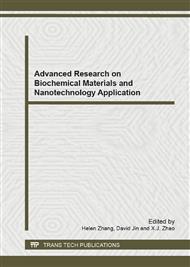p.166
p.170
p.174
p.178
p.182
p.186
p.191
p.195
p.199
Correlated Transitions of Pb/PbO Core-Shell Nanoparticles Induced by Electron Beam Irradiation
Abstract:
Nanoscale thermodynamics and kinetics were explored via the manipulation of Pb/PbO core-shell nanoparticles with a focused electron beam which served as a nanometer heating probe. In the electron transmission microscope (TEM), when an electron beam of moderate intensity was used to irradiate the nanoparticles, the amorphous particles gradually crystallized and showed distinct boundaries between lead cores and oxide shells. In such a way, the oxide shell could be easily measured to be 0.5-2 nanometers. With a high intensity electron beam, melting of the lead cores could be observed, indicating a sufficient local temperature increasing induced by the concentrated heat generated by inelastic electron collisions. The fluidic metal core erupted out through the cracked shells accompanied with the vanish of the boundaries between the cores and shells. Manipulations on nanoparticle decorated carbon wires proved that the lead oxide shells could sustain the irradiation of intense electron beam.
Info:
Periodical:
Pages:
199-202
Citation:
Online since:
January 2013
Authors:
Price:
Сopyright:
© 2013 Trans Tech Publications Ltd. All Rights Reserved
Share:
Citation:


